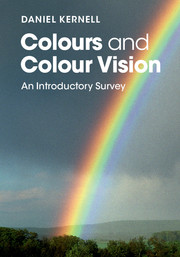Book contents
- Frontmatter
- Dedication
- Contents
- List of plates
- List of figures
- List of tables
- Preface
- 1 Colour vision in everyday life
- 2 The signals of colours: light and wavelengths
- 3 Colours and viewing conditions: not only local wavelengths
- 4 Our biological hardware: eye and brain
- 5 Eyes with unconventional properties: the ‘red-green blinds’
- 6 Other kinds of unconventional colour vision
- 7 Colour vision in different species of animals
- Appendices
- Appendix A Diagnosis and measurement of differences in colour vision
- Appendix B Specification and measurement of colours
- Appendix C Light and lighting
- Appendix D Digital cameras
- Appendix E Technical terms
- Notes
- References
- Index
- Plate section
Appendix A - Diagnosis and measurement of differences in colour vision
from Appendices
Published online by Cambridge University Press: 05 March 2016
- Frontmatter
- Dedication
- Contents
- List of plates
- List of figures
- List of tables
- Preface
- 1 Colour vision in everyday life
- 2 The signals of colours: light and wavelengths
- 3 Colours and viewing conditions: not only local wavelengths
- 4 Our biological hardware: eye and brain
- 5 Eyes with unconventional properties: the ‘red-green blinds’
- 6 Other kinds of unconventional colour vision
- 7 Colour vision in different species of animals
- Appendices
- Appendix A Diagnosis and measurement of differences in colour vision
- Appendix B Specification and measurement of colours
- Appendix C Light and lighting
- Appendix D Digital cameras
- Appendix E Technical terms
- Notes
- References
- Index
- Plate section
Summary
Methods for the testing of colour vision became needed when it was discovered, at the end of the eighteenth century, that a considerable percentage of the population was ‘colour blind’. In the earliest investigations, the testing material often consisted of various colours of cloth. One such test, 20 ribbons in different colours, was used by John Dalton, who asked his participants about the colours of these items in daylight as compared to in candle light (cf. Section 5.1). In the 1870s, Frithiof Holmgren developed a test with skeins of coloured wool (see), using procedures based on colour matching rather than naming. A large number of variously coloured skeins were mixed in a heap. The examiner chose a small number of ‘master skeins’ and then asked the participant to search the heap for other skeins with a similar colour.
Nowadays deficient colour vision is commonly tested with several techniques used in parallel. For a rapid and easy initial diagnosis, one of the many ‘coloured-dot tests’ may be used (Section A.1). For persons found to be colour blind in such a test, it will often be appropriate to add some other procedure for evaluating the degree of colour vision deviation. This might involve a general colour-sorting task, like the D15 test (Section A.2). For certain kinds of occupations, potential employees will be evaluated using colour-identification tasks similar to those encountered in a work situation (e.g. coloured light signals like those used at sea; Section A.3). In scientific contexts, it is important to be able to identify both the degree and the type of deviation; this is best done using a specialized instrument called an anomaloscope (Section A.4). Still other procedures might be added in the future (see Sections A.5 and A.6).
Pseudoisochromatic plates
Ishihara
One of the best and most famous examples of this type of test was developed in Japan by Shinobu Ishihara (1879–1963), a professor of eye diseases at the University of Tokyo. The first edition of his test was published in 1917, around 100 years ago. The test is so well made that it is continuously reprinted, and it remains one of the most frequently used tests for colour blindness.
- Type
- Chapter
- Information
- Colours and Colour VisionAn Introductory Survey, pp. 194 - 203Publisher: Cambridge University PressPrint publication year: 2016



